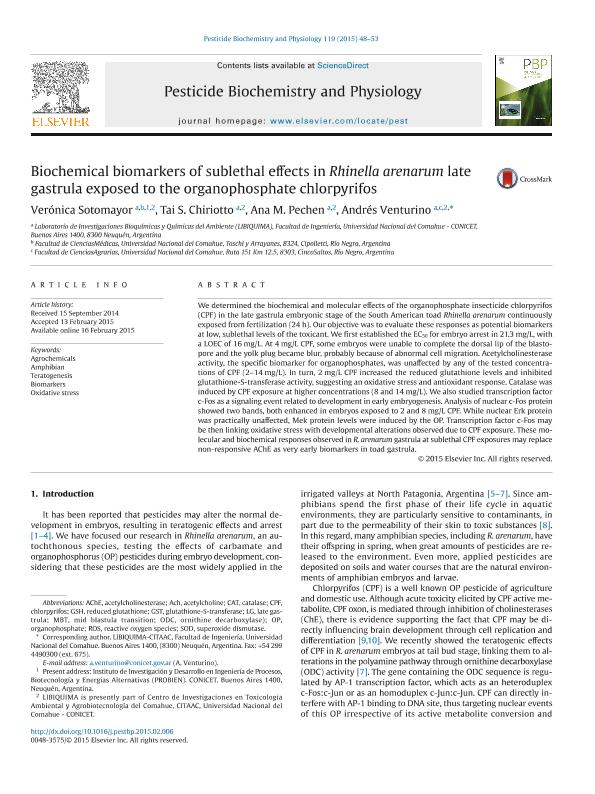Mostrar el registro sencillo del ítem
dc.contributor.author
Sotomayor, Veronica

dc.contributor.author
Chiriotto, Tai Sabrina

dc.contributor.author
Pechen, Ana Maria

dc.contributor.author
Venturino, Andres

dc.date.available
2018-05-08T18:43:08Z
dc.date.issued
2015-03-16
dc.identifier.citation
Sotomayor, Veronica; Chiriotto, Tai Sabrina; Pechen, Ana Maria; Venturino, Andres; Biochemical biomarkers of sublethal effects in Rhinella arenarum late gastrula exposed to the organophosphate chlorpyrifos; Academic Press Inc Elsevier Science; Pesticide Biochemistry And Physiology; 119; 16-3-2015; 48-53
dc.identifier.issn
0048-3575
dc.identifier.uri
http://hdl.handle.net/11336/44465
dc.description.abstract
We determined the biochemical and molecular effects of the organophosphate insecticide chlorpyrifos (CPF) in the late gastrula embryonic stage of the South American toad Rhinella arenarum continuously exposed from fertilization (24 h). Our objective was to evaluate these responses as potential biomarkers at low, sublethal levels of the toxicant. We first established the EC50 for embryo arrest in 21.3 mg/L, with a LOEC of 16 mg/L. At 4 mg/L CPF, some embryos were unable to complete the dorsal lip of the blastopore and the yolk plug became blur, probably because of abnormal cell migration. Acetylcholinesterase activity, the specific biomarker for organophosphates, was unaffected by any of the tested concentrations of CPF (2–14 mg/L). In turn, 2 mg/L CPF increased the reduced glutathione levels and inhibited glutathione-S-transferase activity, suggesting an oxidative stress and antioxidant response. Catalase was induced by CPF exposure at higher concentrations (8 and 14 mg/L). We also studied transcription factor c-Fos as a signaling event related to development in early embryogenesis. Analysis of nuclear c-Fos protein showed two bands, both enhanced in embryos exposed to 2 and 8 mg/L CPF. While nuclear Erk protein was practically unaffected, Mek protein levels were induced by the OP. Transcription factor c-Fos may be then linking oxidative stress with developmental alterations observed due to CPF exposure. These molecular and biochemical responses observed in R. arenarum gastrula at sublethal CPF exposures may replace non-responsive AChE as very early biomarkers in toad gastrula.
dc.format
application/pdf
dc.language.iso
eng
dc.publisher
Academic Press Inc Elsevier Science

dc.rights
info:eu-repo/semantics/openAccess
dc.rights.uri
https://creativecommons.org/licenses/by-nc-sa/2.5/ar/
dc.subject
Agrochemicals
dc.subject
Amphibian
dc.subject
Teratogenesis
dc.subject
Biomarkers
dc.subject
Oxidative Stress
dc.subject.classification
Otras Ciencias Biológicas

dc.subject.classification
Ciencias Biológicas

dc.subject.classification
CIENCIAS NATURALES Y EXACTAS

dc.title
Biochemical biomarkers of sublethal effects in Rhinella arenarum late gastrula exposed to the organophosphate chlorpyrifos
dc.type
info:eu-repo/semantics/article
dc.type
info:ar-repo/semantics/artículo
dc.type
info:eu-repo/semantics/publishedVersion
dc.date.updated
2018-04-09T16:57:29Z
dc.journal.volume
119
dc.journal.pagination
48-53
dc.journal.pais
Estados Unidos

dc.journal.ciudad
Nueva York
dc.description.fil
Fil: Sotomayor, Veronica. Consejo Nacional de Investigaciones Científicas y Técnicas. Centro Científico Tecnológico Conicet - Patagonia Norte. Centro de Investigaciones en Toxicología Ambiental y Agrobiotecnología del Comahue. Laboratorio de Investigaciones Bioquímicas y Químicas del Ambiente | Universidad Nacional del Comahue. Facultad de Ciencias Agrarias. Centro de Investigaciones en Toxicología Ambiental y Agrobiotecnología del Comahue. Laboratorio de Investigaciones Bioquímicas y Químicas del Ambiente; Argentina
dc.description.fil
Fil: Chiriotto, Tai Sabrina. Consejo Nacional de Investigaciones Científicas y Técnicas. Centro Científico Tecnológico Conicet - Patagonia Norte. Centro de Investigaciones en Toxicología Ambiental y Agrobiotecnología del Comahue. Laboratorio de Investigaciones Bioquímicas y Químicas del Ambiente | Universidad Nacional del Comahue. Facultad de Ciencias Agrarias. Centro de Investigaciones en Toxicología Ambiental y Agrobiotecnología del Comahue. Laboratorio de Investigaciones Bioquímicas y Químicas del Ambiente; Argentina
dc.description.fil
Fil: Pechen, Ana Maria. Consejo Nacional de Investigaciones Científicas y Técnicas. Centro Científico Tecnológico Conicet - Patagonia Norte. Centro de Investigaciones en Toxicología Ambiental y Agrobiotecnología del Comahue. Laboratorio de Investigaciones Bioquímicas y Químicas del Ambiente | Universidad Nacional del Comahue. Facultad de Ciencias Agrarias. Centro de Investigaciones en Toxicología Ambiental y Agrobiotecnología del Comahue. Laboratorio de Investigaciones Bioquímicas y Químicas del Ambiente; Argentina
dc.description.fil
Fil: Venturino, Andres. Consejo Nacional de Investigaciones Científicas y Técnicas. Centro Científico Tecnológico Conicet - Patagonia Norte. Centro de Investigaciones en Toxicología Ambiental y Agrobiotecnología del Comahue. Laboratorio de Investigaciones Bioquímicas y Químicas del Ambiente | Universidad Nacional del Comahue. Facultad de Ciencias Agrarias. Centro de Investigaciones en Toxicología Ambiental y Agrobiotecnología del Comahue. Laboratorio de Investigaciones Bioquímicas y Químicas del Ambiente; Argentina
dc.journal.title
Pesticide Biochemistry And Physiology

dc.relation.alternativeid
info:eu-repo/semantics/altIdentifier/doi/http://dx.doi.org/10.1016/j.pestbp.2015.02.006
dc.relation.alternativeid
info:eu-repo/semantics/altIdentifier/url/https://www.sciencedirect.com/science/article/abs/pii/S0048357515000371
Archivos asociados
